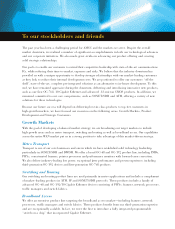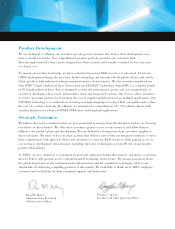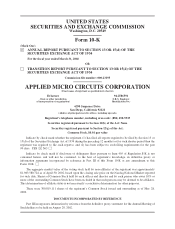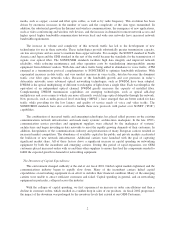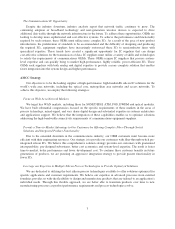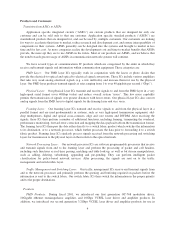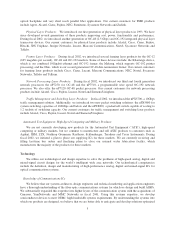3Ware 2002 Annual Report Download - page 13
Download and view the complete annual report
Please find page 13 of the 2002 3Ware annual report below. You can navigate through the pages in the report by either clicking on the pages listed below, or by using the keyword search tool below to find specific information within the annual report.Representatives do not maintain a product inventory; instead, their customers place orders directly with us or
through distributors. Our sales headquarters is located in San Diego, California. We maintain sales offices
throughout the world.
Backlog
Our sales are made primarily pursuant to standard purchase orders for the delivery of products. Quantities of
our products to be delivered and delivery schedules are frequently revised to reflect changes in customers’ needs,
and customer orders generally can be canceled or rescheduled without significant penalty to the customer. For
these reasons, our backlog as of any particular date is not representative of actual sales for any succeeding period,
and we therefore believe that backlog is not a good indicator of future revenue.
Competition
In the communications IC markets, we compete primarily against companies such as Agere, Broadcom,
Conexant, Infineon, Intel, Maxim, Multilink, PMC-Sierra, TriQuint and Vitesse. In addition, certain of our
customers or potential customers have internal IC design or manufacturing capability with which we compete.
Many of our competitors operate their own fabrication facilities and have longer operating histories and presence
in key markets, greater name recognition, larger customer bases and significantly greater financial, sales and
marketing, manufacturing, distribution, technical and other resources than we do. As a result, these competitors
may be able to adapt more quickly to new or emerging technologies and changes in customer requirements or
devote greater resources to the promotion and sale of their products.
The communications IC markets are highly competitive and are subject to rapid technological change,
evolving standards, short product life cycles, price erosion and heightened international competition. We believe
that the principal factors of competition for the markets we serve include: product performance, quality,
reliability, integration, price and time-to-market as well as the Company’s reputation and level of customer
support. Our ability to successfully compete in these markets depends on our ability to design and subcontract the
manufacture of new products that implement new technologies and gain end market acceptance in an efficient
and cost effective manner.
Proprietary Rights
We rely in part on patents to protect our intellectual property. We have been issued 61 patents, which
principally cover certain aspects of the design and architecture of our IC products. In addition, we have over
200 inventions in various stages of the patent process in the United States and abroad. There can be no assurance
that our pending patent applications or any future applications will be approved, or that any issued patents will
provide us with competitive advantages or will not be challenged by third parties or that if challenged, will be
found to be valid or enforceable, or that the patents of others will not have an adverse effect on our ability to do
business. There can be no assurance that others will not independently develop similar products or processes,
duplicate our products or processes or design around any patents that may be issued to us.
To protect our intellectual property, we also rely on a combination of mask work protection under the
Federal Semiconductor Chip Protection Act of 1984, trademarks, copyrights, trade secret laws, employee and
third-party nondisclosure agreements and licensing arrangements.
As a general matter, the semiconductor industry is characterized by substantial litigation regarding patent
and other intellectual property rights. In the past we have been, and in the future may be, notified that we may be
infringing the intellectual property rights of third parties. We have certain indemnification obligations to
customers with respect to the infringement of third party intellectual property rights by our products. There can
be no assurance that infringement claims by third parties or claims for indemnification by customers or end users
of our products resulting from infringement claims will not be asserted in the future or that such assertions, if
8


